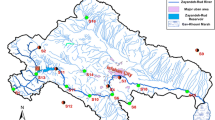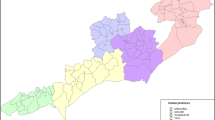Abstract
Adaptation aims at increasing the resilience of natural and human systems to current and future impacts of climate change. The main objective of the current research is to introduce an innovative methodological framework which can effectively assess adaptation measures in basins with severe water deficits by coupling hydrology, climate change and management scenarios, leading to accurate decision making. In this paper, both supply and demand adaptation measures were proposed in line with various regional, national and European policies in order to improve the severe water problem of the Mygdonia basin. The overexploitation of the surface water systems (Lakes Koronia and Volvi) and groundwater resources of the Mygdonia basin during the previous decades, along with the projected decrease of the future water availability, due to climate change, accentuate the need for concerted action towards adaption to climate change. The measures include the increase of a stream diversion towards Lake Koronia, the increase of the embankment elevation at the outfall point of Lake Volvi, the restructuring of crops and their combinations. The measures were examined in terms of their sustainability and effectiveness in the short-term (2020–2050) and long-term (2050–2080) future periods under the most reliable climatic model. The results indicate that the application of demand management measures is more efficient compared to supply oriented solutions for addressing the future water deficit of the Mygdonia water system. The combination of crop restructuring and the decrease of agricultural land proved to be the most efficient and sustainable solution.











Similar content being viewed by others
References
Bobori D, Tsavdaroglou F, Bafeiadou A, Patsia A, Karta E, Kravva M, Tekidis E, Koulogiannis S, Avramidis A, Poulia A, Sidiras G, Stampouli A, Chairopoulos T, Papadopoulou G, Gkorezi C (2016) Annual report of the management body of lakes Koronia and Volvi. Management body of lakes Koronia and Volvi. Lagkadas, Greece
Burek P, Satoh Y, Fischer G, Kahil MT, Scherzer A, Tramberend S, Nava LF, Wada Y, Eisner S, Flörke M, Hanasaki N, Magnuszewski P, Cosgrove B, Wiberg D (2016) Water futures and solution: fast track initiative - final report, Austria
Connell-Buck CR, Medellín-Azuara J, Lund JR, Madani K (2011) Adapting California’s water system to warm vs. dry climates. Clim Chang 109(1):133–149. https://doi.org/10.1007/s10584-011-0302-7
Danish Hydraulic Institute (DHI) (2017a) MIKE HYDRO Basin, User Guide. http://manuals.mikepoweredbydhi.help/2017/Water_Resources/MIKEHydro_Basin_UserGuide.pdf. Accessed 22 November 2017
Danish Hydraulic Institute (DHI) (2017b) MIKE HYDRO River, User Guide. http://manuals.mikepoweredbydhi.help/2017/Water_Resources/MIKEHydro_River_UserGuide.pdf. Accessed 12 September 2017
Danish Hydraulic Institute (DHI) (2017c) MIKE SHE, Volume 1: User Guide. http://manuals.mikepoweredbydhi.help/2017/Water_Resources/MIKE_SHE_Printed_V1.pdf. Accessed 15 September 2017
Dessai S, Hulme M, Lempert R, Pielke R (2009) Do we need better predictions to adapt to a changing climate? EOS 90(13):111–112
Greek Ministry of Environment, Energy and Climate Change (2012) Final determination of heavily modified water bodies and artificial water bodies. Water District of Central Macedonia. Athens, pp. 55
Esteve P, Varela-Ortega C, Blanco-Gutiérrez I, Downing TE (2015) A hydro-economic model for the assessment of climate change impacts and adaptation in irrigated agriculture. Ecol Econ 120:49–58. https://doi.org/10.1016/j.ecolecon.2015.09.017
Exarchou Nikolopoulos Bensasson S.A. (ENM) (2007) Greek Biotope – Wetland Centre, Danish Hydraulic Institute (DHI) Water Management Plan for Water Districts, Systems and Tools Development for the Water Resources Management of the Water Districts of Western Macedonia, Central Macedonia, Eastern Macedonia and Thrace (in Greek). Technical Report, Athens, Greece
Georgalas S, Mamasis N (2015) Estimation of ecological flow at the Marathon reservoir. Management and Utilization. Tenth International Conference of the Greek Geographical Association. http://geolib.geo.auth.gr/index.php/pgc/article/view/10558. Accessed 10 November 2019
Greek Ministry of Environment, Energy and Climate Change (2013) Analysis of pressures and impacts on surface water and groundwater resources, Athens
Gudmundsson L (2016) Statistical transformations for post-processing climate model output. Package qmap. http://cran.r-project.org/web/packages/qmap/qmap.pdf. Accessed 14 June 2016
Hanak E, Lund JR (2012) Adapting California’s water management to climate change. Clim Chang 111(1):17–44. https://doi.org/10.1007/s10584-011-0241-3
Iglesias A, Garrote L, Diz A, Schlickenrieder J, Moneo M (2013) Water and people: assessing policy priorities for climate change adaptation in the Mediterranean. In: Navarra A, Tubiana L (eds) Regional assessment of climate change in the Mediterranean. Springer, Netherlands, pp 201–233
IPCC (2014) Freshwater resources. In: Field CB, Barros VR, Dokken DJ, Mach KJ, Mastrandrea MD, Bilir TE, Chatterjee M, Ebi KL, Estrada YO, Genova RC, Girma B, Kissel ES, Levy AN, MacCracken S, Mastrandrea PR, White LL (eds) Climate Change 2014: Impacts, Adaptation, and Vulnerability. Part A: Global and Sectoral Aspects. Contribution of Working Group II to the Fifth Assessment Report of the Intergovernmental Panel on Climate Change. Cambridge University Press, Cambridge, United Kingdom and New York, pp 229–269
Jahandideh-Tehrani M, Haddad OB, Loáiciga HA (2015) Hydropower reservoir management under climate change: the Karoon reservoir system. Water Resour Manag 29:749–770. https://doi.org/10.1007/s11269-014-0840-7
Kahil MT, Connor JD, Albiac J (2015) Efficient water management policies for irrigation adaptation to climate change in southern Europe. Ecol Econ 120:226–233. https://doi.org/10.1016/j.ecolecon.2015.11.004
Kaur S, Lubana PPS, Aggarwal R (2013) Groundwater management for adaptation under changing climate conditions in Indian Punjab. J Water Clim Change 4:38–51. https://doi.org/10.2166/wcc.2013.038
Kolokytha E, Oishi S, Teegavarapu RSV (2017) Sustainable water resources planning and management under climate change. Springer, Singapore
Lash D, Ward S, Kershaw T, Butler D, Eames M (2014) Robust rainwater harvesting: probabilistic tank sizing for climate change adaptation. J Water Clim Change 5:526–539. https://doi.org/10.2166/wcc.2014.080
López-Bellido L, Wery J, López-Bellido RJ (2014) Energy crops: prospects in the context of sustainable agriculture. Eur J Agron 60:1–12. https://doi.org/10.1016/j.eja.2014.07.001
Loukas A, Mylopoulos N, Vasiliades L (2007) A modeling system for the evaluation of water resources management strategies in Thessaly, Greece. Water Resour Manag 21:1673–1702. https://doi.org/10.1007/s11269-006-9120-5
Majkut J (2017) Climate science: a guide to the public debate. Niskanen Center. https://niskanencenter.org/wp-content/uploads/2017/03/NISKANEN-CLIMATE-PRIMER-2017-03-13.pdf. Accessed 05 July 2019
Malamataris D, Kolokytha E, Loukas A (2019) Integrated hydrological modeling of surface water and groundwater under climate change: the case of Mygdonia Basin in Greece. J Water Clim Change (in press). https://doi.org/10.2166/wcc.2019.011
Manakou V, Tsiakis P, Kungolos A (2013) A mathematical programming approach to restore the water balance of the hydrological basin of Lake Koronia. Desalin Water Treat 51:2955–2976. https://doi.org/10.1080/19443994.2012.748444
Masood M, Takeuchi K (2016) Climate change impacts and its implications on future water resource management in the Meghna Basin. Futures 78:1–18. https://doi.org/10.1016/j.futures.2016.03.001
Ojeda-Bustamante W, Ontiveros-Capurata RE, Flores-Velázquez J, Iñiguez-Covarrubias M (2016) Changes in water demands under adaptation actions to climate change in an irrigation district. J Water Clim Change 8:191–202. https://doi.org/10.2166/wcc.2016.028
Omikron LLC (2005) Environmental impact assessment of wetland and deep habitats establishment. Region of Central Macedonia, Thessaloniki
Swart R, Bernstein L, Ha-Duong M, Petersen A (2009) Agreeing to disagree: uncertainty management in assessing climate change, impacts and responses by the IPCC. Clim Chang 92:1–29. https://doi.org/10.1007/s10584-008-9444-7
Tennant DL (1976) Instream flow regimens for fish, wildlife, recreation and related environmental resources. Fisheries 1:6–10
Veranis, N. 2010 Hydrogeological study of Mygdonias, Mavroudas, Agiou Orous, Xolomonta, Olympiadas, Asprolakka, Ierissou, and notion Rodon groundwater systems (in Greek). Technical Report, Thessaloniki, Greece, pp. 430
WWAP (UNESCO World Water Assessment Programme) (2019) The United Nations world water development report 2019: leaving no one behind. UNESCO, Paris
Zalidis GC, Takavakoglou V, Alexandridis T (2004) Revised Restoration Plan of Lake Koronia, Thessaloniki
Acknowledgments
This research was funded by the IKY FELLOWSHIPS OF EXCELLENCE FOR POSTGRADUATE STUDIES IN GREECE – SIEMENS PROGRAM. Special thanks to DHI for the kind provision of the software MIKE SHE, MIKE HYDRO River and MIKE HYDRO Basin licence that was used for the modelling tasks of this paper.
Author information
Authors and Affiliations
Corresponding author
Ethics declarations
Conflict of Interest
None.
Additional information
Publisher’s Note
Springer Nature remains neutral with regard to jurisdictional claims in published maps and institutional affiliations.
Rights and permissions
About this article
Cite this article
Kolokytha, E., Malamataris, D. Integrated Water Management Approach for Adaptation to Climate Change in Highly Water Stressed Basins. Water Resour Manage 34, 1173–1197 (2020). https://doi.org/10.1007/s11269-020-02492-w
Received:
Accepted:
Published:
Issue Date:
DOI: https://doi.org/10.1007/s11269-020-02492-w




